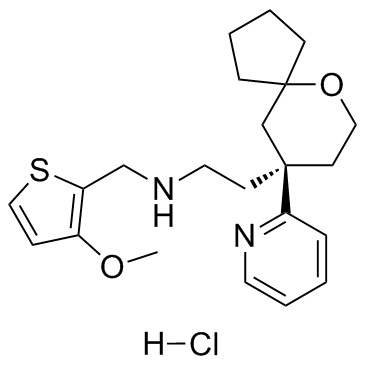| Description |
Oliceridine hydrochloride (TRV130 hydrochloride) is a G protein biased μ opioid receptor agonist with an pEC50 of 8.1.
|
| Related Catalog |
|
| In Vitro |
Oliceridine (TRV130) elicits robust G protein signaling, with potency and efficacy similar to morphine, but with far less β-arrestin recruitment and receptor internalization[2].
|
| In Vivo |
Oliceridine (TRV130) treatment produces robust antinociception, complete inhibition of gastrointestinal function, and weak abuse-related effects in mice[1]. Oliceridine (TRV130) displays an ED50 of 0.9 mg/kg in an analgesic assay. Oliceridine analgesia is reversible in mice by administration of 3 mg/kg naloxone s.c. 15 minutes after Oliceridine dosing. In the rat 52°C hot plate, Oliceridine is 10-fold more potent than morphine with ED50 of 0.32 and 3.2 mg/kg, respectively. Oliceridine (0.3 mg/kg, s.c.) possesses an improved therapeutic index of analgesia to constipation relative to morphine in mice[2]. Oliceridine (TRV130; 1.2 mg/kg, s.c.) significantly depresses respiration of mice[3].
|
| Kinase Assay |
Equilibrium binding of unlabeled compounds is measured by inhibition of radioligand binding ([3H]-diperenorphine) to HEK cell membranes expressing human MOR, KOR, and DOR. Unlabeled ligand and buffer (50 mM Hepes, 5 mM MgCl2, 1 mM EGTA and 0.05% bovine serum albumin, pH 7.2, at 23°C) containing radioligand are added to polypropylene 96-well plates. Assays are initiated by the addition of membrane (5-10 μg protein/well) suspension. The concentration of [3H]-diprenorphine (specific activity 50-52 Ci/mmol), is 0.5-1 times the independently determined Kd. Compounds are diluted in DMSO and tested at a final concentration of 1% DMSO. Nonspecific binding is defined in the presence of 1 μM naloxone. Competition assays are performed at 23°C for 3-4 hours to allow adequate time for equilibrium binding. In all assays, total radioligand bound to the filter is less than 10% of the total radioligand added. The separation of bound from free radioligand is accomplished by rapid vacuum filtration of the incubation mixture over GF/B filter mats using a Brandel cell harvester. Filters are washed 2 times with 0.5 mL of ice-cold phosphate buffered saline pH 7.0 containing 0.01% Triton ×100. Radioactivity on the filters is quantified using a MicroBeta TriLux Liquid Scintillation Counter.
|
| Animal Admin |
Analgesia-like responses in are measured using a hotplate analgesia meter with dimensions of 29.2 × 26.7 cm with mice restricted to a cylinder 8.9 cm in diameter and 15.2 cm high. Response is measured by recording the latency to lick, flutter, or splay hind paw(s), or an attempt to jump out of the apparatus at 55 °C, with a maximum cut-off time of 30 s. Once a response is observed or the cut-off time had elapsed, the subject is immediately removed from the hotplate and placed back in its home cage. The animals are acclimated to the hotplate, while cool, and a baseline analgesic response time is acquired several hours before drug treatment and testing. Mice are injected with either vehicle (n=8), morphine (5 mg/kg, n=8 or 10 mg/kg, n=8), Oliceridine (1.2 mg/kg, n=9) or PZM21 (10 mg/kg, n=8; 20 mg/kg, n=11; or 40 mg/kg, n=8). After injection of drug, the analgesic effect expressed as percentage maximum possible effect (%MPE) is measured at 15, 30, 60, 90 and 120 min after drug treatment. If animals do not display hind paw lick, splay, or flutter, they are removed from the trial. Additionally, if animals attempt to jump out of the plate or urinated on the hotplate they are removed from the trial. To assess analgesia by the tail-flick assay, a tail-flick analgesia meter. Mice are gently immobilized with a cotton towel and the tail base is placed on a radiant light source emitting a constant temperature of 56 °C. The tail withdrawal latency is measured at similar time points as the hotplate assay after administration of vehicle (n=8), morphine (5 mg/kg, n=4; 10 mg/kg, n=8) or PZM21 (10 mg/kg, n=8; 20 mg/kg; n=14). The cut-off time for the heat source is set at 10 s to avoid tissue damage. Analgesic response times are measured similar to the hotplate assay
|
| References |
[1]. Altarifi AA, et al. Effects of acute and repeated treatment with the biased mu opioid receptor agonist TRV130 (oliceridine) on measures of antinociception, gastrointestinal function, and abuse liability in rodents. J Psychopharmacol. 2017 Jan 1:2698811166 [2]. DeWire SM, et al. A G protein-biased ligand at the μ-opioid receptor is potently analgesic with reduced gastrointestinal and respiratory dysfunction compared with morphine. J Pharmacol Exp Ther. 2013 Mar;344(3):708-17. [3]. Manglik A, et al. Structure-based discovery of opioid analgesics with reduced side effects. Nature. 2016 Sep 8;537(7619):185-190
|
